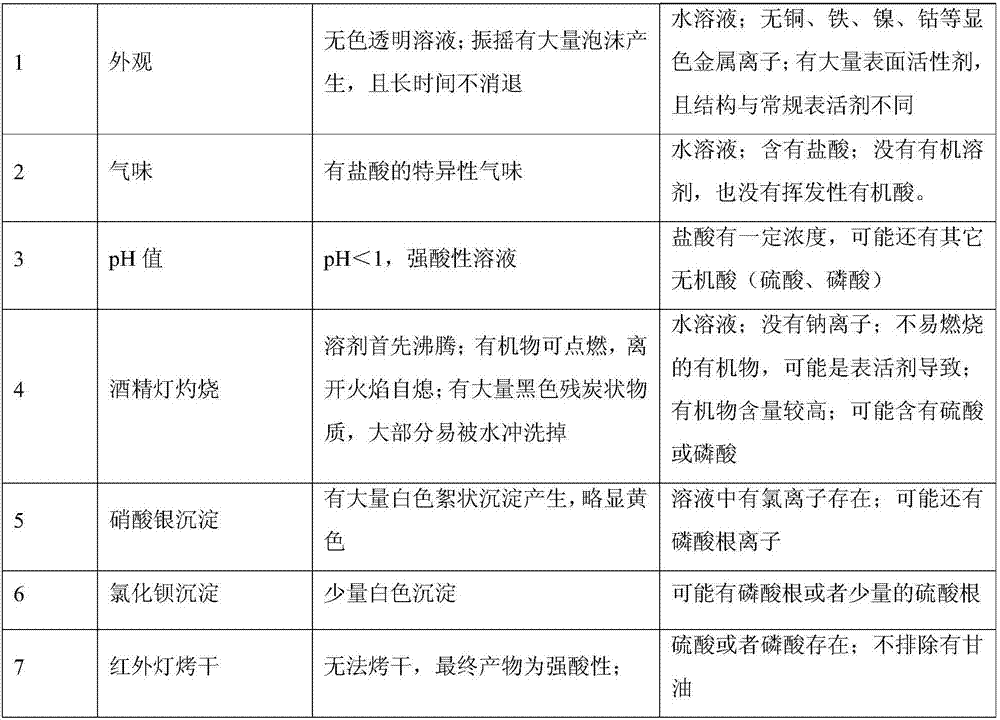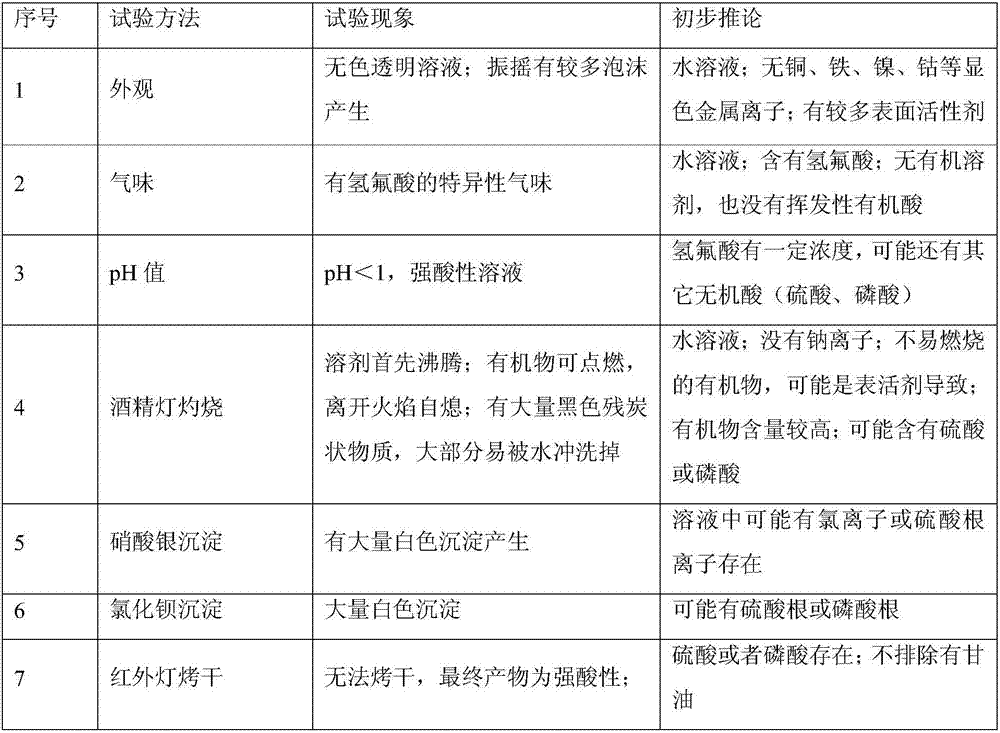Analysis method of acid solution
An acidic solution and solution technology, applied in the field of analysis and testing, can solve the problems of difficult identification, affect separation, increase the interference of salt substances, etc., and achieve the effects of low price, reduced interference, and easy availability.
- Summary
- Abstract
- Description
- Claims
- Application Information
AI Technical Summary
Problems solved by technology
Method used
Image
Examples
Embodiment 1
[0026] The sample (sample 1) of this embodiment is an aqueous solution, which is composed of the following substances: hydrochloric acid, phosphoric acid, benzotriazole, and stearyl polyoxyethylene (30) ether. It is used in the field of electroplating.
[0027] Firstly, the pre-experiment was carried out according to Table 2. It can be preliminarily inferred from the preliminary experiment that the sample is an aqueous solution containing hydrochloric acid, possibly sulfuric acid or phosphoric acid, a large amount of surfactant, and a special structure.
[0028] Table 2 Pre-experimental method of sample 1
[0029]
[0030]
[0031]Then the sample is separated. According to the aforementioned method, calcium carbonate should be added for neutralization and separation. Take a 150mL empty beaker weighing 47.06g. Add about 10mL of sample with a disposable dropper to obtain a total weight of 56.98g, so the sampling volume of the sample is 9.92g. Add calcium carbonate gra...
Embodiment 2
[0037] The sample (sample 2) of this embodiment is an aqueous solution, which is composed of the following substances: hydrofluoric acid, sulfuric acid, potassium sulfate, and isodecyl alcohol polyoxyethylene (9) ether. It is used in the field of metal cleaning.
[0038] Firstly, the pre-experiment was carried out according to Table 4. It can be preliminarily inferred from the preliminary experiment that the sample is an aqueous solution containing hydrofluoric acid, possibly sulfuric acid or phosphoric acid, and more surfactants. Since the sample contains hydrofluoric acid, a glass beaker cannot be used for neutralization, but a plastic beaker must be used.
[0039] Table 4 Pre-experimental method of sample 2
[0040]
[0041] Then the sample is separated. According to the aforementioned method, calcium carbonate should be added for neutralization and separation. Take a 150mL empty beaker weighing 16.13g. Add about 10mL of sample with a disposable dropper to obtain a ...
Embodiment 3
[0047] The sample (sample 3) of this embodiment is an organic solvent solution, which consists of the following substances: chloroform, methanol, and sulfuric acid.
[0048] Firstly, the pre-experiment was carried out according to Table 6. It can be preliminarily inferred from the preliminary experiment that the sample is an organic solvent solution containing chloroform and possibly sulfuric acid or phosphoric acid. Since it is an organic solvent solution, there may be no other components.
[0049] Table 6 Pre-experimental method of sample 3
[0050]
[0051] The volatile gas components were then analyzed using Headspace GC-MS (Headspace GC-MS). The results showed that the sample contained chloroform and methanol, the relative content was about 1:1.
[0052] Then the sample is separated. According to the aforementioned method, calcium carbonate should be added for neutralization and separation. Take a 150mL empty beaker weighing 47.12g. Add about 10mL of sample with ...
PUM
 Login to View More
Login to View More Abstract
Description
Claims
Application Information
 Login to View More
Login to View More - R&D
- Intellectual Property
- Life Sciences
- Materials
- Tech Scout
- Unparalleled Data Quality
- Higher Quality Content
- 60% Fewer Hallucinations
Browse by: Latest US Patents, China's latest patents, Technical Efficacy Thesaurus, Application Domain, Technology Topic, Popular Technical Reports.
© 2025 PatSnap. All rights reserved.Legal|Privacy policy|Modern Slavery Act Transparency Statement|Sitemap|About US| Contact US: help@patsnap.com



